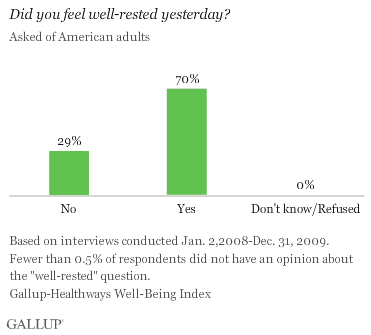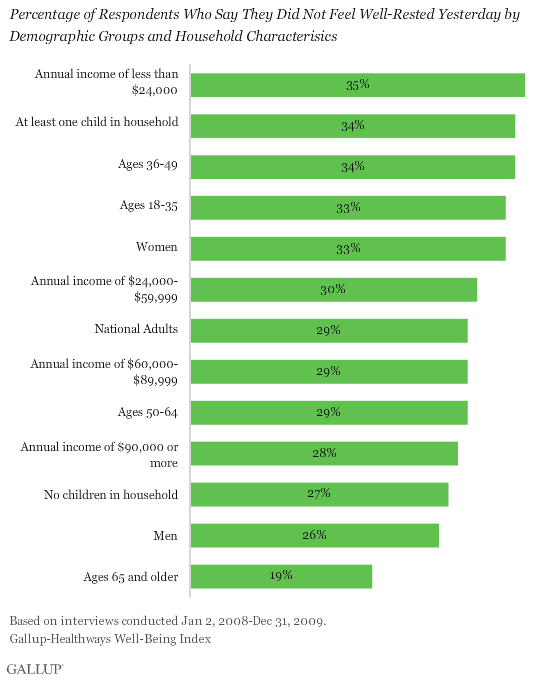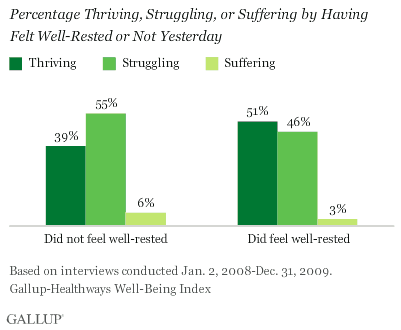WASHINGTON, D.C. -- Three in 10 Americans on average (29%) said they did not feel well-rested "yesterday," according to Gallup-Healthways data from 2008 and 2009. The remaining 70% reported feeling well-rested the day before the survey.

Income, Age, Gender, and Presence of Children Make a Difference
The lowest income Americans, those aged 49 and younger, women, and those with children under the age of 18 in the household are among the groups most likely to say they were not well-rested yesterday -- with one-third or more in each group saying so.
Americans aged 50 and older, those with the highest incomes, men, and those without children in the household are among those least likely to report not having felt well-rested -- with each group coming in at or under the national average of 29%.

There is almost no variation in feeling well-rested among the four largest U.S. ethnic groups. Rates of not feelings well-rested fall between 28% and 30% for whites, blacks, Hispanics, and Asian Americans.
Exploring the Differences Among Demographic Groups
Retirement status may explain why older Americans are more likely to say they feel well-rested. Among Americans of all ages, 78% of retirees say they feel well-rested compared with 64% of non-retirees. However, these data also reflect that those 65 and older make up the large majority of the retired population.
Any of a wide range of factors that are correlated with income could have influenced lower income Americans' reports of not feeling well-rested the day before the survey. These factors include, among others, greater daily stress, greater financial worry, lower job satisfaction, and poorer physical health compared with wealthier respondents.
The gender difference in not feeling well-rested seems to be independent of the other effects examined in this article. Men were more likely than women to report feeling well-rested across age and income groups and regardless of whether a household had any children under the age of 18. For example, the gender difference in not feeling well-rested was six percentage points for people without children in their household and eight points for people with children in their household.
Finally, the connection between having children in one's household and not feeling well-rested also occurs across the various demographic groups. For instance, the effect of having children in the household was almost as strong for men as it was for women. The one exception to this generalization is that having children in the household bore a weak connection to being well-rested among respondents aged 36 to 49. The gap in feeling well-rested was less than two points in this specific age group.
It All Adds Up
Although some of the demographic variables examined overlap substantially, all of the variables seem to be uniquely related to whether people feel well-rested. Taken together, income, age, gender, and having children under the age of 18 in the household have a large cumulative connection to feeling well-rested. Thirteen percent of men aged 65 and older in the highest income group who report not having children in the home report not feeling well-rested. The percentage who do not feel well-rested more than triples -- to 44% -- among women aged 36 to 49 who are in the lowest income group and who have children under 18 in the home.
The Well-Rested Tend to Be Thriving
Feeling well-rested is important not only in its own right, but also because it is connected to general life evaluations. Almost 4 in 10 Americans (39%) who report not having felt well-rested yesterday evaluate their present and future lives favorably enough to be categorized as thriving, based on their responses to the . This increases to 51% among those who said that they did feel well-rested. Moving from those who do not feel well-rested to those who do, one's likelihood of being classified as struggling decreases nine points, and one's likelihood of being classified as suffering is cut in half -- from 6% to 3%.

Even holding all the aforementioned demographic variables constant, those who feel well-rested still report higher life evaluations. For instance, focusing on women aged 65 and older who are in the highest income group and who do not have children in the household, there is a 16-point "thriving gap" between those who do not feel well-rested compared with those who do (39% vs. 55% thriving). At the other extreme, for men aged 18 to 35 in the lowest income group who do have children in the home, the thriving gap between those who do not feel well-rested and those who do is 13 points (28% versus 41% thriving).
Learn more about the .
Survey Methods
Results are based on telephone interviews with more than 700,000 national adults, aged 18 and older, conducted Jan. 2, 2008-Dec. 31, 2009. There are at least 97,000 adults in every major demographic group analyzed, and thus the margins of error for all groups are less than +1 percentage point. Interviews are conducted with respondents on landline telephones (for respondents with a landline telephone) and cellular phones (for respondents who are cell phone-only and cell phone mostly).
Interviews are conducted with respondents on landline telephones (for respondents with a landline telephone) and cellular phones (for respondents who are cell phone-only and cell phone mostly).
In addition to sampling error, question wording and practical difficulties in conducting surveys can introduce error or bias into the findings of public opinion polls.
About the Gallup-Healthways Well-Being Index™
The Gallup-Healthways Well-Being Index measures the daily pulse of U.S. wellbeing and provides best-in-class solutions for a healthier world. To learn more, please visit .
